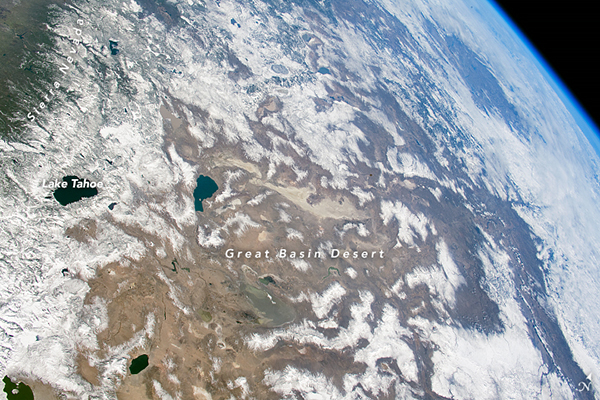
by Elizabeth Dengler Wednesday, May 16, 2018

Snow cover across much of the U.S. West can be seen in this photo, taken from the International Space Station on March 3. Credit: ISS Crew Earth Observations Facility and the Earth Science and Remote Sensing Unit, Johnson Space Center, NASA
Scientists have long assumed that temperature is the main control on melting of winter snowpacks across the mountainous western United States. In a recent study, however, scientists suggest that regional humidity may have a larger impact than temperature.
Winter snowpack and spring melt are important sources of water in many heavily populated areas, such as the U.S. West, and the Himalayan and Andean regions, so it is important to understand the potential impacts of these regional changes, says Adrian Harpold, a hydrologist at the University of Nevada, Reno, and lead author of the new study, published in Proceedings of the National Academy of Sciences. “We’re interested in how the melt pattern of snow is going to change, both the timing and the amount of melt, as a consequence of climate change and climate variability,” Harpold says.
Harpold, along with Paul Brooks of the University of Utah, investigated how factors other than “sensible heat” — the heat we feel in the air, which is measured as temperature — affect snowpack accumulation and seasonal ablation, or loss, caused by sublimation or melting. They assessed the ranges in temperature and humidity at more than 450 sites where data were collected between 1985 and 2015. The sites, located across the western U.S., from the Pacific Northwest to the Southwest, had average winter temperatures ranging from minus 8.9 to 2.9 degrees Celsius.
The researchers found that snowpack melting did not necessarily correlate with warmer temperatures. Also, although there was significant winter warming at more than half the sites over the 30-year timeframe of the study, snowpack ablation did not correlate uniformly with this long-term warming trend. This highlights that “temperature alone is an insufficient predictor of seasonal snow cover,” Harpold and Brooks wrote in the study.
Northern Hemisphere snowpacks begin developing in fall and early winter each year as the amount of incoming solar radiation drops to a minimum and air temperatures cool. However, as solar radiation increases again through winter and spring, snowpacks are typically shielded from the effects of rising temperatures by high albedo, or reflectivity, which means the snow absorbs less incoming radiation.
But other factors also come into play. In particular, Harpold says, “humidity changes how the energy in the atmosphere interacts with the snowpack.” When there is higher humidity, he says, it reduces the ability of snowpacks to withstand warmer air temperatures, allowing melting to occur. This is largely due to “latent” energy released or absorbed when water changes phase. When water vapor in humid air condenses on a snowpack, the heat released warms the snow, allowing for increased melting even when air temperatures are at or just below freezing.
The researchers found regional differences in the way snowpack ablation occurred, and the timing of ablation, related to humidity levels. “Across all locations, higher absolute humidity was associated with faster melt rates, consistent with large latent energy fluxes warming the snowpack,” they wrote in the study. Under more humid winter conditions, such as those typically seen in the Pacific Northwest, snowpacks experienced midwinter ablation events dominated by melting that totaled 202 millimeters of snow water equivalent (SWE) per year on average. These midwinter melt events — often followed by snow-accumulation events — averaged three days in length and were especially pronounced in areas where warmer temperatures and high atmospheric humidity overlapped.
In arid regions like the Southwest, however, there were fewer midwinter ablation events, which resulted in an average loss of only 58 millimeters of SWE per year. In these regions ablation occurred primarily through sublimation, a phase transition in which water changes directly from solid to gas, which cools the snowpack, “allowing it to persist through the winter,” Harpold says. This cooling typically helps delay spring melting and reduces melt rates. But over the timeframe of the study, the researchers found that the start of the melt season in arid regions began to come earlier and the season persisted for longer, which could have negative implications for melting. “When you spread the melt out over a longer period, there are more opportunities for water losses through evaporation and transpiration, so we end up with less water in the streams and our groundwater,” Harpold says.
While the overall humidity of a region is an important controlling factor on snowpacks in the short term, long-term shifts in regional humidity may have a greater effect on changing snowpacks in the future, says Thomas Painter, a principal scientist at NASA’s Jet Propulsion Laboratory in Pasadena, Calif. He adds that areas that experience both humid and arid climate regimes may be more susceptible to long-term changes in humidity as climates change and temperatures rise overall. This could, in turn, have profound impacts on regional spring melt, and ultimately on the amount of consumable water available to these populations. Mountain snowpacks do not cover huge spatial extents, but “the dependency of people on the water resources from those relatively small areas is immense,” Painter says, and changes in the timing and amount of runoff will require alterations to water management techniques to store more water in reservoirs, for example.
Currently, many operational water supply decisions are based on models that rely primarily on temperature, without considering other primary controls such as humidity, solar radiation and precipitation, Harpold says. But such decisions, he adds, “may miss some really important regional considerations driven by other factors.”
© 2008-2021. All rights reserved. Any copying, redistribution or retransmission of any of the contents of this service without the expressed written permission of the American Geosciences Institute is expressly prohibited. Click here for all copyright requests.